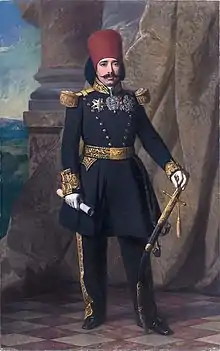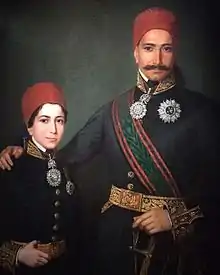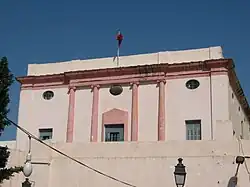Mustapha Khaznadar
Mustapha Khaznadar (Arabic: مصطفى خزندار; 1817–1878), born as Georgios Halkias Stravelakis (Greek: Γεώργιος Χαλκιάς Στραβελάκης) was a Tunisian politician who served as Prime Minister of the Beylik of Tunis from 1855 to 1873.[1][2] He was one of the most influential people in modern Tunisian history.[3]
Mustapha Khaznadar | |
|---|---|
 A portrait of Mustapha Khaznadar in 1846 by Charles-Philippe Larivière. | |
| Prime Minister of Tunisia | |
| In office 1855 – 22 October 1873 | |
| Monarchs | Muhammad II Muhammad III |
| Preceded by | Mustapha Saheb Ettabaa |
| Succeeded by | Kheireddine Pacha |
| Minister of Finance | |
| In office 1837 – 22 October 1873 | |
| Monarchs | Ahmad I Muhammad II Muhammad III |
| Personal details | |
| Born | August 3, 1817 Kardamyla, Greece |
| Died | July 26, 1878 (aged 60) Tunis, Beylik of Tunis |
| Resting place | Tourbet el Bey |
| Spouse | Princess Lalla Kalthoum |
Biography
Early life
Mustapha Khaznadar was born in the village of Kardamyla on the Greek island of Chios[1][3][4][5][6] as Georgios Halkias Stravelakis[4][7][8] in 1817.[7][9][10] In January 1822, rebels from the neighboring islands of Samos arrived on Chios and declared their independence from the Ottoman Empire, the Ottoman sultan soon sent an army of about 40,000 to the island of Chios, where roughly 52,000 Greek inhabitants were massacred and tens of thousands of women and children were taken into slavery.[11][12] During the Chios massacre, Georgios's father, the sailor Stephanis Halkias Stravelakis, was killed, while Georgios along with his brother Yannis were captured and sold into slavery by the Ottomans.[10] He was then taken to Smyrna and then Constantinople, where he was sold as a slave to an envoy of the Husainid Dynasty.
Religious conversion and political career
The young Georgios was taken by the family of Mustapha Bey, and was renamed Mustapha.[10] Later, he was passed to his son Ahmad I Bey[5] while he was still crown prince. The young Mustapha now worked first as the prince's private treasurer before becoming Ahmad's state treasurer (Khaznadar).[5] He managed to climb to the highest offices of the Tunisian state, married Princess Lalla Kalthoum in 1839 and was promoted to lieutenant-general of the army, made bey in 1840 and then speaker of the Grand Council from 1862 to 1878.
In 1864, Mustapha Khaznadar, then Prime Minister, during efforts to raise the taxation of the Tunisian peasants to meet the demands of the Ottoman Empire faced a rebellion, known as the Mejba Revolt, that almost overthrew the regime. However, the government was swift to act and ultimately suppressed the uprising.[13]
Mustafa Khaznadar retained memories of his Greek origin [14] and when he finally managed, he made contact with his remaining family and helped to pay for the education of his two (Greek) nephews.[15] Khaznadar died in 1878 and is buried in the mausoleum of Tourbet el Bey, in the heart of the Medina of Tunis.
Gallery
 Painting of Mustapha Khaznadar and his son.
Painting of Mustapha Khaznadar and his son. Khaznadar during his career as Prime Minister.
Khaznadar during his career as Prime Minister. Equestrian portrait of Muhammad III, Khaznadar is just behind him.
Equestrian portrait of Muhammad III, Khaznadar is just behind him. Khaznadar Palace, which he built for himself.
Khaznadar Palace, which he built for himself. Tomb of Khaznadar in Tourbet el Bey, near his wife Lalla Kalthoum.
Tomb of Khaznadar in Tourbet el Bey, near his wife Lalla Kalthoum.
Honours
.gif) Officer of the Order of the Blood (Nichan Dam) of Tunisia (1856)
Officer of the Order of the Blood (Nichan Dam) of Tunisia (1856).svg.png.webp) Officer of the Order of Glory (Nichan Iftikhar) of Tunisia
Officer of the Order of Glory (Nichan Iftikhar) of Tunisia
References
Notes
- Fage 1982, p. 173.
- Morsy 1984, p. 185.
- Ziadeh 1962, p. 11.
- Shivji 1991, p. 235.
- Association of Muslim Social Scientists & International Institute of Islamic Thought 2008, p. 56
- Rowley & Weis 1986, p. 190; Singh 2000, p. 1102.
- Binous & Jabeur 2002, p. 143.
- Gallagher 2002, p. 125.
- Tūnisī & Brown 1967, p. 22.
- Simon, Mattar & Bulliet 1996, p. 1018.
- "Η Ιστορία της Χίου και τα Μεσαιωνικά Χωριά της". chioshistory.gr. Archived from the original on 2011-10-02.
- Rosenblum & Janson 1984, p. 125.
- "Tunisia - The Growth of European Influence". www.britannica.com. Retrieved 2009-10-09.
- Bosworth 1993, p. 717.
- Gallagher 2002, p. 75.
Sources
- Association of Muslim Social Scientists; International Institute of Islamic Thought (2008). The American Journal of Islamic Social Sciences. Vol. 25. American Journal of Islamic Social Sciences. OCLC 60626498.
- Binous, Jamila; Jabeur, Salah (2002). Houses of the Medina: Tunis. Dar Ashraf Editions. OCLC 224261384.
- Bosworth, Clifford Edmund (1993). The Encyclopaedia of Islam. Brill. ISBN 90-04-09419-9.
- Fage, John D. (1982). The Cambridge History of Africa: From the Earliest Times to c. 500 BC, Volume 1. Cambridge University Press. ISBN 0-521-22803-4.
- Gallagher, Nancy Elizabeth (2002). Medicine and Power in Tunisia, 1780-1900. Cambridge University Press. ISBN 0-521-52939-5.
- Morsy, Magali (1984). North Africa, 1800-1900: A Survey from the Nile Valley to the Atlantic. Longman. ISBN 0-582-78377-1.
- Rosenblum, Robert; Janson, Horst Woldemar (1984). 19th Century Art. Abrams. ISBN 0-8109-1362-3.
- Rowley, Harold Henry; Weis, Pinkas Rudolf (1986). Journal of Semitic Studies, Volumes 31-32. Manchester University Press. OCLC 1782837.
- Shivji, Issa G. (1991). State and Constitutionalism: An African Debate on Democracy. SAPES Trust. ISBN 0-7974-0993-9.
- Simon, Reeva S.; Mattar, Philip; Bulliet, Richard W. (1996). Encyclopedia of the Modern Middle East, Volume 2. Macmillan Reference USA. ISBN 0-02-897062-4.
- Singh, Nagendra Kr. (2000). International Encyclopaedia of Islamic Dynasties. Anmol Publications PVT. ISBN 81-261-0403-1.
- Tūnisī, Khayr al-Dīn; Brown, Leon Carl (1967). The Surest Path: The Political Treatise of a Nineteenth-century Muslim Statesman. Harvard University Press. OCLC 683802.
- Ziadeh, Nicola A. (1962). Origins of Nationalism in Tunisia. Librarie du Liban. OCLC 3062278.
- "Η Ιστορία της Χίου και τα Μεσαιωνικά Χωριά της". chioshistory.gr. Archived from the original on 2011-10-02.
